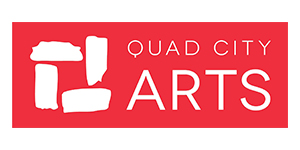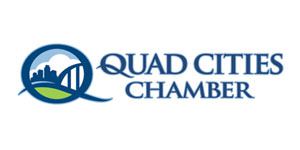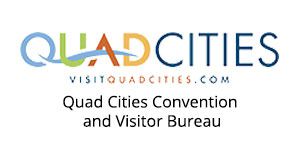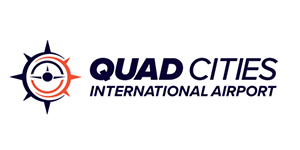Moline Public Art Plan Aims to Bring More Joy, Color to Life
Saturday in the Arts is a weekly feature covering a trend, subject, event or personality of local interest. It runs every Saturday morning on  your site for the best entertainment and arts coverage in the area, QuadCities.com!
your site for the best entertainment and arts coverage in the area, QuadCities.com!
Especially after this past year, we could all use more joy, color, light and life in our lives, and backers of a new public art plan for Moline want that all for downtown.
This past week, Moline Mayor Stephanie Acri and the City Council heard a presentation on the new 102-page Public Art and Placemaking Plan, commissioned by Renew Moline and the city.
A nine-member Public Art Steering Committee (formed in late 2019) guided the consultant selection and recommended Designing Local, based in Columbus, Ohio, which assembled the plan and has worked with similar projects nationwide.
Amanda Golden — an urban planner, principal in the firm and certified placemaker — got input from over

Amanda Golden, a principal with Designing Local, led the Moline public art plan process.
200 people for the plan, through surveys, in-person and virtual stakeholder meetings, including downtown merchants and residents.
“We want people to come to Moline for the public art,” she told the council, which did not vote on the plan (to come later this month). “Overwhelmingly, we heard that public art in Moline should be bold and iconic. It should reflect that Midwestern charm that you all know and love. It should become synonymous with the city and the Quad-Cities’ brand.
“Public art should connect us to one another,” Golden told the council. “We’re all coming out of this last year wanting to feel more connected to our neighbors and friends and family. Public art does this, by creating comfortable and joyous public spaces.”
They don’t want to superimpose what’s been done in other cities, but make public art “a uniquely Quad-Cities experience,” she said. “We really want to showcase what is really so special about the Quad-Cities.”

Kevin Maynard is executive director of Quad City Arts.
They want artwork that is diverse, not only the in medium but the artists creating it, and people that are reflected in the art itself, Golden said.
Kevin Maynard, executive director of Quad City Arts, was a member of the Public Art Steering Committee that guided the development of the plan. He said, “Public art drives creative placemaking, increases civic pride, and helps strengthen a local economy.
“Pre-Covid, cultural tourism was on the rise and is predicted to return stronger than before and cultural tourists spend nearly twice as much when visiting,” he said. “Additionally, more people are looking at whether a community is rich in the arts when deciding where to locate for a job, especially among younger demographics.”
Maynard (with the others attending Tuesday night’s council meeting remotely) told elected officials this is Moline’s chance to dream big.
“Amanda has put together a public art master plan that is thorough and workable, and it could make Moline a leader in public art in our region,” he said. “It could set the tone that the Quad-Cities can be the arts hub of the Midwest. Public art helps drive tourism and it’s become increasingly more important for people as they look at places to locate to. That level of importance ranks higher with younger demographics.”
Public art tightly aligns with the Q2030 strategic plan, helping to create a cool, creative community and strengthen civic pride, Maynard said.
“I do think it’s something that will add value, in economic development and tourism,” Dave Herrell, Visit Quad Cities president/CEO and
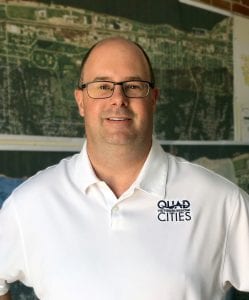
Dave Herrell is president/CEO of Visit Quad Cities.
another committee member, told council. “People have an emotional connection to art. I think it can do so many different things, as we think about how we want to evoke the characteristics of Moline – that authenticity of Moline.”
“Amanda knocked it out of the park on a lot of different levels,” he said. “I just think, it’s such a great thing for our region and the city of Moline.”
Later this week, Herrell said there are strong leaders already providing sculptures, murals and other art in public spaces throughout the Q-C, like Quad City Arts’ annual public art placement and Metro Arts student projects.
“I think Quad City Arts is really a treasure in our region and I think Kevin and his team are doing some phenomenal things,” Herrell said. “Obviously, there are a lot of other folks and then how we support local artists. I think people need to understand that public art and creative energy within our community, it is so economically important.
“It’s so important that public art is realized,” he added. “It’s relevant and competitive from a talent attraction and people attraction perspective.
“How are you bringing in visitors? Almost 10 times out of 10, I can guarantee you if a community has a strong public art scene, that’s going to
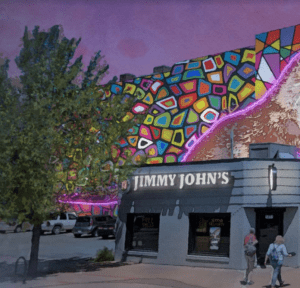
A rendering of a possible mural on the Analog Arcade building at 5th Avenue and 14th Street.
be a community that understands the value of economic development, and they’re going to be more successful at it. So it is a broader picture that I think public art can help our community grow and get stronger.”
Public art is a component of the tourism master plan that Visit Quad Cities completed last June, Herrell said. Its main vision says the Q-C “is a proud, forward-thinking, visitor-centric region connected by the storied Mississippi River and a shared love of local, independent arts, culture and creativity.”
The home page for the master plan online shows a large public mural in downtown Davenport.
Moline’s plan was developed with a strong public outreach component. A series of “Walkabout Talkabout” public art walks were originally scheduled last April and had to be conducted virtually.
Amanda Golden said, “Even despite challenges presented by the pandemic, we were pleased to have over 200 individuals participate in our activities. We got a lot of great feedback that is reflected in the plan. As an example, we had not listed Sylvan Island as a potential site for art, but we heard about it so often in our community meetings that we added it, and it now appears in the plan as a concept site.”
Golden also expressed her pride in the work, citing significant participation by the community in developing the plan.
It includes a multi-pronged funding strategy that is designed to infuse “Cultural Corridors” with public art, and relies on a mix of public, private and grant funds to fulfill the vision. It also contains seven “Conceptual Projects” at key locations in downtown, with colorful ideas for inspiration.
A unique partnership
“Public art provides meaning to public spaces, reflects the history of a city, adds uniqueness to neighborhoods, and humanizes the built environment,” the plan says.
“Public art lives at the intersection between our past, present, and future, and has the power to transform public spaces. The City of Moline is
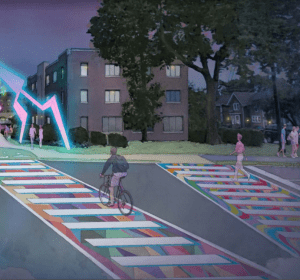
A rendering of potential Moline streetscape art in downtown.
committed to developing a strong public art program and this plan is an important first step in creating the foundation for the program to grow upon.”
The foreword to the plan – penned by Mayor Acri, Renew Moline board chair Carrie O’Neill, and Moline Foundation board chair Larry Meeske – says: “A unique partnership has made this Public Art and Placemaking Plan possible.
“Together, we have established a vision for downtown. We have laid out our aspirations for corridors and public spaces that are animated and inviting, and specific areas that will be enhanced under this Plan.
“These spaces will be assets to our public realm and our downtown and will make downtown a more vibrant place to live, work, play, visit and learn,” it says. “It directs diversity both in the type of art that will be implemented, and in the people it represents. The ideas contained in the Plan were generated largely by stakeholders. Despite doing outreach during a pandemic, over 100 individuals participated in various stakeholder meetings, first in person, and then virtually.”
“Building a dynamic urban core animated by public art contributes to economic vitality by creating places where people want to be and to invest,” the foreword says. The $50,000 plan was paid mainly by The Moline Foundation.
One suggested public art plan envisions a new city riverfront park, under where the old I-74 bridge is. The City Council has voted to endorse the concept of a riverfront park (yet to be designed, funded or constructed), and the new plan notes Schwiebert Park in Rock Island is an example of a successful waterfront park, which is seven acres and cost approximately $10 million.
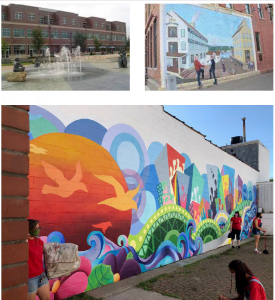
Examples of existing public art in downtown Moline.
“Using Schwiebert Park as a standard for the type and quality of improvements, one could expect a 1.5-acre Moline riverfront park to cost about $2.2 million,” the plan says, adding with an estimated 2% percent for art, $44,000 would be required, for a total project cost of $2,244,000, and new art would be incorporated into the proposed park.
The seven concept locations proposed for downtown Moline art are:
- Sylvan Island, with environmental art and nature play equipment.
- 19th Street and 7th Avenue, with pedestrian scale artwork to help improve safety and enliven the area.
- River Drive at new I-74 ramp, with a monumental gateway sculpture that could cost $500,000 to $1 million.
- Welcome words (in concrete or other media) at 19th Street and 5th
- 15th Street overpass at River Drive with 15 interactive LED lights.
- A mural at a blank wall on Analog Arcade Bar, 5th Avenue and 14th
- Small lit sculptures at the Q parkway, at northeast corner of 12th Street and 4th Avenue, at new rail station.
Adding public art – including sculpture, murals, paint on pavement, and lights – adds color and vibrancy, and can change and enhance what is “necessary, but possibly boring infrastructure,” Golden said in her presentation.
These experiences will draw increased foot traffic throughout downtown and will encourage pedestrians to experience the layers of historic architecture, local businesses, and public art, the plan says.
In addition to focusing investment in public art along corridors downtown, the city and its local partners should stack cultural experiences along these corridors to create rich experiences that are enhanced by the addition of public art.
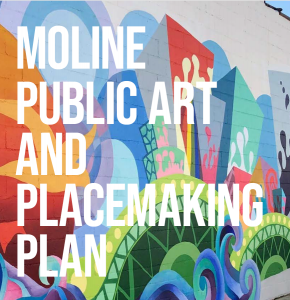
The cover of the 102-page Moline Public Art and Placemaking Plan.
“Investments could include interpretative signage, concerts and performances, parklets, and art and farmers’ markets,” the plan says. “By designating specific corridors for a higher level of scrutiny, a combination of public and private dollars will invest in placemaking projects that use public art as a lever for further economic investment.”
The Moline plan proposes four cultural corridors:
- 19th Street from 7th Avenue to the riverfront
- River Drive from 12th to 34th streets
- 5th and 6th avenues from 6th to 23rd streets
- 12th Street from 5th Avenue to River Drive
“These cultural corridors will be used to drive investment,” Golden said, noting the program could be expanded beyond downtown.
She told the council that the city should allocate $100,000 a year for public art (to be managed by an appointed seven-member Public Art Commission), as well as dedicating 2 percent of city capital improvement projects for art, only downtown. For private development, the plan recommends that 1 percent of each total project budget go for public art (with a $100,000 cap).
“If developers are hesitant about doing that, they are welcome to contribute 80 percent of that 1 percent to a public art fund at the city of Moline, that the commission can then use for public art downtown,” Golden said.
Of the seven proposed projects in the plan, four do not fall within an existing or proposed TIF district that can fund their implementation. Therefore, an annual budget allocation will ensure their implementation.
How does Moline compare to other cities?
The public art plan and commission would be the first of its kind in the Q-C area, according to the Moline Plan Commission. Golden has worked with over 30 cities nationwide to craft public art plans (some encompass arts and culture), to determine how to best spend money on
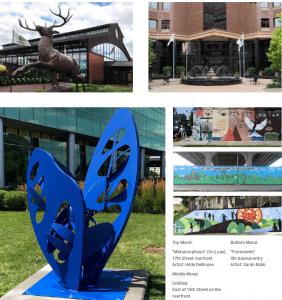
Examples of existing public art in downtown Moline.
the arts.
It’s not very common for cities to adopt both public annual allocations and percentage spending on public art, she said. “Moline is in a unique position, so you guys have really set yourselves up to be ripe for development, but that’s just not happening right now,” she said in a Thursday interview.
“We’re recommending you put these policies in place that will set you up for success, when development starts happening,” Golden said. “We don’t want to just wait until that happens. We’d love to see that move forward and really spur development, and be part of that thing that draws private investment, but also encourages public investment all through downtown.”
Designing Local is working in some cities that “are growing like gangbusters,” like the Atlanta suburbs, she said. “That doesn’t mean Moline can’t have a really robust public art program; it just means we have to think a little different about how it’s funded.”
In cities that are having lots of private development, they pair that with public projects like streetscaping, road expansion, parks and art, Golden said. In cities that have these art plans and policies, many of them have been in place since the ‘80s, she noted.
Designing Local has never worked in a comparable area that has sizable cities that make up that region, Golden said. “When we first came to Moline, we were blown away by the regionalism,” she said. “We’ve never worked in a place that is not focused on itself, but focused on the region as a whole. That is not normal.”

Alexandra Elias is president/CEO of Renew Moline.
The proposed cultural corridors help connect amenities throughout downtown.
“We’re all kind of saying, what are the things we did before the pandemic that didn’t bring us joy?” she asked. “How can the city be a partner in providing the opportunity to bring joy to people? And art is that – especially if it’s free.”
“Cities around the country are not stopping procurement for these projects; they’re increasing it,” Golden said. “Many cities are saying, we need a plan for public art. It’s not only the pandemic – we’re coming out of a time where we’re reckoning who we are as a country. We’re saying, how can we provide opportunities for representation of all people, all backgrounds, colors and races?”
They just finished a plan in Akron, Ohio (which has about 200,000 people), with a funding mechanism that attaches a 1-percent fee for public art on any projects that use TIF funding throughout the city. (Tax-increment financing, or TIF, uses increased tax revenue within a designated area for projects only within that district.)
“That service fee is on top of any development using the TIF funding,” she said. They also did a project for Fort Wayne, Ind., which also is similar to the Q-C, using their TIF – requiring developers to give back 1 percent of what they get in TIF incentives at the beginning of the project, to a public art fund.

Moline Ald. Sam Moyer, 5th Ward, was on the Public Art Steering Committee.
According to Akron’s public art site, its program is governed by a Public Art Commission that stewards the city’s investment on behalf of the people of Akron. The Public Art Commission only reviews public art being commissioned by the city, using city funds, or on public property. Private businesses commissioning work for their property and using their money do not fall under the purview of the city.
Last June, Akron Mayor Daniel Horrigan said:
“Just like healthy public spaces, access to arts and culture is a fundamental right for those living in an equitable and free society. The task of the Akron Cultural Plan was to capture the current state of our arts and culture landscape and imagine its future, by engaging the community members who live, work, and create in Akron. Through this deeply collaborative process, we learned that many of our residents and artists feel disconnected from public art and that was something we knew had to change.”
The Kentucky capital city of Frankfort this week adopted the Designing Local public art master plan there.
“Places like Moline, we’re able to come in and understand the background and the strengths and weaknesses of those policies,” Golden said this week.
Usually, the practice in a “percent for art” requirement is that developers can have public art on their property.
Many communities offer opportunities for developers to contribute money to an art fund – giving them 20 percent off the total cost if they donate to the city fund, Golden said.
“Some people go so far as requiring 2 percent, with 1 percent cash deposit,”: she said. “It’s really about what the city wants and how they want to push, and what the council can stomach.”
It’s likely the city planning department would devote a staff person to be the city liaison for the program, Golden said.

An example of illuminated sculptures in the Moline plan.
She credited Quad City Arts – which provides copious public art in the region – as “highly regarded,” and “they’re really doing great work.”
“Kevin is so knowledgeable about public art and its power,” Golden said of the arts group executive director. “so he was wonderful to have on the steering committee.”
Moline’s plan is about complementing what Quad City Arts does, not replacing it, she said.
In Fort Wayne, they’re experiencing “a significant amount of revitalization throughout the City, resulting in a significant investment in planning efforts,” according to Designing Local. “Because of this, the City adopted an ordinance requiring any private development receiving TIF incentives to contribute 1% of the project fee to the City of Fort Wayne’s Public Art Fund.”
Percent-for-art programs require a portion of a city’s Capital Improvement Project budget per year go to commissioning of public artworks, which will usually be sited in, on, or adjacent to the building or project being constructed.
Percent-for-art ordinances guarantee a funding stream for public art projects regardless of what happens to city budgets or arts funding, the Moline plan says. The policy also guarantees that public art projects will be planned each year, as long as CIPs are underway and municipal construction continues.
Plan sets out the details
In addition to pages of bright, bold and colorful illustrations as examples and inspiration for public art, the Moline plan includes a much drier appendix that lays out the details on how the program would work. It includes policies for use of funds, acquisition of art, artist selection process for public art, developer guidelines, art donation procedures, and how to maintain and manage the art collection.
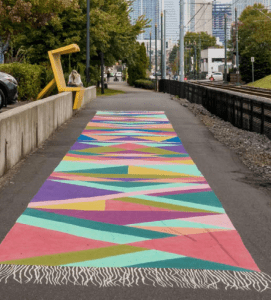
An example of public pavement art in the Moline plan.
The Public Art Commission would act in an advisory capacity to Moline staff and the city in any matter pertaining to public art. It would advise and make recommendations to the city pertaining to, among other things, policies and
procedures as identified in the Administrative Guide; artist selection juries and process; commission and placement of artworks; and maintenance and removal of artworks.
The commission would be a citizen committee (ideally comprised of art professionals) appointed by the mayor and Moline City Council. The council and mayor would retain ultimate responsibility for the program. Day-to-day responsibility for the program will reside within the Planning Department, with a dedicated staff person managing it.
The staff liaison will oversee the program, as well participate in the planning, purchasing, commissioning, donation, placement, handling, conservation, and maintenance of public artwork under the jurisdiction of all city departments.
The plan includes an administrative guide that outlines the roles and responsibilities of citizens, city staff and elected officials in the development, funding and implementation of the City of Moline Public Art Program. It would only apply to projects using city funding on public property.
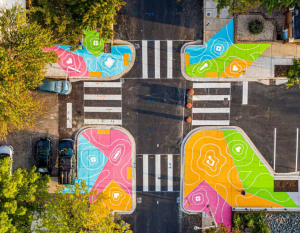
An example of painted crosswalk art in the Moline plan.
The plan provides guidelines and requirements for the development of an annual Public Art Work Plan, the funding and acquisition of public art, the selection of artists and artwork, the implementation and conservation of the Moline Public Art Collection.
“I’m not sure how the city would like to administer the Public Art Commission, but we would work with the Public Art Commission to establish a request for proposals, the call for entries,” said Renew Moline CEO Alexandra Elias, noting the commission likely would include members that have been on the steering committee.
“The visuals that are in the draft plan that talk about those concepts and those ideas, for those specific locations are only ideas,” she said. “It doesn’t mean in any way that those are the art features that are gonna be in those locations. The whole idea is that we’ve identified that areas need to have a grand scale, and they need to be lit. “And they need to be interactive in certain locations and not interactive in others,” Elias said. “All of those things would be under the purview of the Public Art Commission to decide.”
The council will meet on April 13 to discuss a proposed public art ordinance, which will include many of the policies and procedures in the plan, Golden said.
Lots of valuable input
Elias said Renew and Designing Local were very proud of the outreach built into gathering input for public art, including virtual meetings.
“We still feel like we’ve got a really great cross-section of opinions and viewpoints and ideas,” Elias said. “As an example, one of the things that when we walked into the walkabout and talk about public art, we had six sites identified that we thought were pretty ripe for public art. But when we were in those meetings and when we were talking with people, the thing that kept coming up with Sylvan Island and we ended up adding Sylvan Island as the seventh concept site for some kind of public art project.
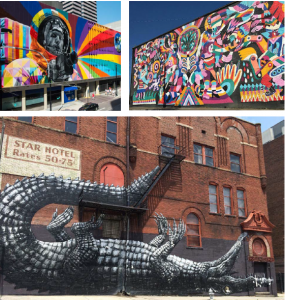
Examples of building murals in the Moline plan.
“That’s exactly why we do public reviews. So we were thrilled about that and happy to add it,” she said, noting that the new 74 bridge and land to be vacated by the old bridge present great opportunities for art development.
“When you get off the bridge from Iowa at River Drive, that’s one of our sites. And we think that’s a really important site because it’s your welcome into downtown, also the state of Illinois and eastern United States of America,” Elias said. “So we think that that is a really important landing site.”
“We’ve really tried to be expansive and thinking about this and make sure that it is for everyone,” she said of plans. “We went through a really important cultural shift. The George Floyd tragedy happened during our stakeholder outreach, and that definitely is something that was on our radar. There were murals that were done (in Minneapolis and many other cities, honoring Floyd) after that, “because the community was in pain and then healing,” Elias said. “And I think there’s so many ways that public art is of tremendous value to a community, and so we look at it for economic development. But we also look at it as part of our culture and how we experience each other and how we heal from what’s been a difficult year all around.
“The value of public art is not just to increase investment from businesses or residents moving to the area, but to serve residents already

Existing downtown Moline sculptures and streetscaping.
here, obviously,” she said.
Moline’s plan is happening on the heels of major public improvement projects in the area – including the new I-74 bridge, the planned airport renovations, Visit Quad Cities’ tourism master plan, and implementing the Quad Cities Chamber Q2030 plan.
“The stars are aligned – everybody is working toward the same goal – making a better place to live, work and invest,” Golden said Thursday. “All these organizations are being empowered to make really progressive decisions and investments, and I think it’s all coming to fruition at the same time, which is awesome.”
Moline 5th Ward Ald. Sam Moyer, who served on the Public Art Steering Committee, said public art has a “central, vital role in the redevelopment of our downtown, our tourism industry, and our own community pride. I appreciate the hard work over the past year of Alex Elias, the public art committee, and our consultant Amanda Golden,” he said by e-mail.
“A large number people in our community participated in discussions and assisted in developing a plan that is inspiring and intentional. And that is what we wanted. Public art can be haphazard, and often is in many communities,” Moyer said. “We wanted a guiding document that would be bold, capture what it means to be in Moline, and to ensure that our investments in public art are strategic and well-maintained.
“Public art is an investment and as such, must provide a sensible return on that investment,” the alderman said. “Civic pride is one return and so is creating a personal, charming environment where locals and visitors enjoy spending their time and will return to again and again.”

A rendering of the completed I-74 bridge from the Bettendorf side.
The art of placemaking is to “create those dynamic public spaces that attract commercial investment, that attract people, provide for interactive experiences, and draws regional and national attention to your city as a cultural destination,” Moyer said. “ Our plan does this.”
He agreed the timing of this is perfect, with the redevelopment of the $1.2 billion I-74 bridge.
“Moline has a golden opportunity to shape its downtown for decades to come. Public art will play a leading role in our ability to attract the best investment and create a place where we all enjoy spending time and entertainment dollars,” Moyer wrote.
“The plan also mixes in a variety of art forms, from murals to stand-alone sculpture. There is diversity built in to reflect our community, our past, and our future. It will be interactive and inviting, allowing guests to experience it and share it through social media. The plan is adaptable and builds upon our existing art and regional features.”
Geoff Manis, the Main Street program manager for the city of Moline, who wasn’t involved in the process, said this week: “Moline Centre is thrilled about the City of Moline potentially adopting a comprehensive and long term plan for art installations throughout the downtown Moline cityscape.
“When we think about all of wonderful developments that have occurred to our downtown’s main streets over the past 20 to 30 years, from

The public art plan includes priorities for city action and details on how to implement program policies and procedures.
the TaxSlayer Center to the Bass Street Landing, we feel that the stage has been set and it is time to decorate the place.
“That’s not to say that there is not already many fantastic examples of public art currently installed throughout our downtown,” Manis said. “But any art advocate will tell you, there is always room for more art in the art gallery, or in this case the streetscapes of downtown Moline.
“We commend Renew Moline’s Public Art Steering Committee for all of the hard work that they have done to get the plan to where it is today,” he said. “The Moline Centre will be enthusiastically standing by to help posture, complement, and maintain the Public Art Master Plan in any way we can.”
Golden noted that everyone points to Chicago’s Millennium Park as the high-profile pinnacle of a public-private partnership that used public art as a central attraction. (“The Bean,” finished in 2006, anyone?)
Millennium Park was first proposed in 1997 by then Mayor Richard M. Daley to transform an old industrial wasteland, and world-renowned artists, architects, planners, landscape architects and designers were tapped to create the popular 24.5-acre park.
“Public land, private development,” she said, noting it takes such partnerships in funding as well. In the Chicago park’s case, it went wildly over budget, with the city funding $270 million of the total $475-million cost.
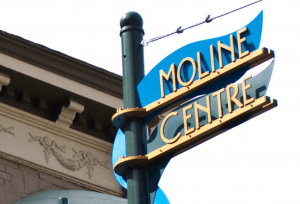
Moline Centre is the brand name for downtown.
During the downtown Moline planning process, this past October, Renew Moline led unveiling of a new public art project (part of the downtown master plan) at the vacant Spiegel building, 200 20th St. The commissioned mural, on several ground floor panels, was done by Brandon Nees, a 25-year-old Davenport artist who graduated from Moline High School.
He painted the word “possibility” in big turquoise block letters across seven plywood panels – among nine colorful 7.6-foot-by-6.75 feet panels he created for a $10,000 public mural on the boarded-up ground floor of the city-owned Spiegel building off River Drive in downtown Moline.
Through a competitive process led by the city and Renew Moline, Nees’s proposal was chosen from among 28 submissions.
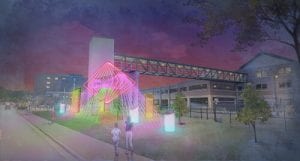
A proposed light display for the area next to the planned passenger rail station at 12th Street and 4th Avenue.
The purpose of the Spiegel mural project was to beautify and draw attention to the building, a city-owned asset and important piece of the historic fabric of downtown. The four-story Spiegel building is also at the center of the redevelopment area created by the I-74 bridge project.
That public art project is designed to both encourage dialogue about the future development of the area and create curiosity and interest in the building, by imagining the “possibility.”
Since then, it’s been hard to win private development interest, given the challenges that with active bridge demolition going on now, Elias said.
“From the feedback we have gotten from the development community earlier, was that everyone just wanted to wait until the bridge was down,” she said. “A few months from now, you’ll see an increased interest. But like I’m working with the city separately on identifying some development parameters around what will happen there no matter what the use is, no matter who the developer is.
“We would like to see an active ground floor and potentially some kind of restaurant uses on the roof,” Elias said of Spiegel. “I have a lot of work to do honestly on that. For example, I just got a proposal for to do a structural assessment of the building to see if it can support a restaurant on the roof. So, like, I’m in the middle of the due diligence for that.”
To see the entire downtown Moline public art plan, click HERE. For more information on Renew, visit www.renewmoline.com/.







